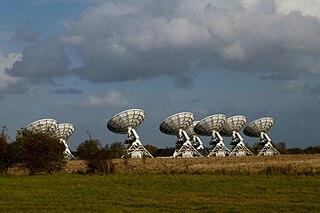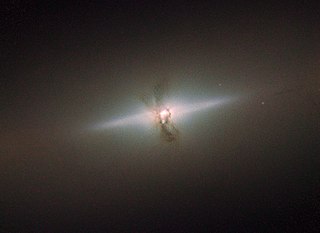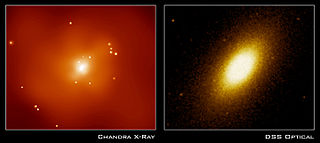
Donald Lynden-Bell CBE FRS was a British theoretical astrophysicist. He was the first to determine that galaxies contain supermassive black holes at their centres, and that such black holes power quasars. Lynden-Bell was President of the Royal Astronomical Society (1985–87) and received numerous awards for his work, including the inaugural Kavli Prize for Astrophysics. He worked at the University of Cambridge for his entire career, where he was the first director of its Institute of Astronomy.

The Centaurus A/M83 Group is a complex group of galaxies in the constellations Hydra, Centaurus, and Virgo. The group may be roughly divided into two subgroups. The Cen A Subgroup, at a distance of 11.9 Mly, is centered on Centaurus A, a nearby radio galaxy. The M83 Subgroup, at a distance of 14.9 Mly, is centered on the Messier 83 (M83), a face-on spiral galaxy.

The Mullard Radio Astronomy Observatory (MRAO) is located near Cambridge, UK and is home to a number of the largest and most advanced aperture synthesis radio telescopes in the world, including the One-Mile Telescope, 5-km Ryle Telescope, and the Arcminute Microkelvin Imager. It was founded by the University of Cambridge and is an institute of the Cambridge University Astronomy Department.
The Third Cambridge Catalogue of Radio Sources (3C) is an astronomical catalogue of celestial radio sources detected originally at 159 MHz, and subsequently at 178 MHz.

The Arcminute Microkelvin Imager (AMI) consists of a pair of interferometric radio telescopes - the Small and Large Arrays - located at the Mullard Radio Astronomy Observatory near Cambridge. AMI was designed, built and is operated by the Cavendish Astrophysics Group. AMI was designed, primarily, for the study of galaxy clusters by observing secondary anisotropies in the cosmic microwave background (CMB) arising from the Sunyaev–Zel'dovich (SZ) effect. Both arrays are used to observe radiation with frequencies between 12 and 18 GHz, and have very similar system designs. The telescopes are used to observe both previously known galaxy clusters, in an attempt to determine, for example, their masses and temperatures, and to carry out surveys, in order to locate previously undiscovered clusters.
The University of Cambridge has three large astronomy departments as follows:

Malcolm Sim Longair is a British physicist. From 1991 to 2008 he was the Jacksonian Professor of Natural Philosophy in the Cavendish Laboratory at the University of Cambridge. Since 2016 he has been editor-in-chief of the Biographical Memoirs of Fellows of the Royal Society.
The 9C survey at 15 GHz (9C) is an astronomical catalogue generated from the radio observations of the Ninth Cambridge survey at 15 GHz. It was published in 2003 by the Cavendish Astrophysics Group of the University of Cambridge. The catalogue was originally made in order to locate radio sources which were interfering with observations using the Very Small Array, but the catalogue has also proved useful for other astronomical programs.

The NGC 4038 Group is a group of galaxies in the constellations Corvus and Crater. The group may contain between 13 and 27 galaxies. The group's best known galaxies are the Antennae Galaxies, a well-known interacting pair of galaxies.
The 7C Survey (7C) of radio sources was performed by the Cavendish Astrophysics Group using the Cambridge Low-Frequency Synthesis Telescope at Mullard Radio Astronomy Observatory.
Przybylski's Star, or HD 101065, is a rapidly oscillating Ap star at roughly 355 light-years from the Sun in the southern constellation of Centaurus.

Somak Raychaudhury is an Indian astrophysicist. He is the Director of the Inter-University Centre for Astronomy and Astrophysics (IUCAA), Pune. He is on leave from Presidency University, Kolkata, India, where he is a Professor of Physics, and is also affiliated to the University of Birmingham, United Kingdom. He is known for his work on stellar mass black holes and supermassive black holes. His significant contributions include those in the fields of gravitational lensing, galaxy dynamics and large-scale motions in the Universe, including the Great Attractor.

Hercules A is a bright astronomical radio source within the vicinity of the constellation Hercules corresponding to the galaxy 3C 348.

NGC 4111 is a lenticular galaxy in the constellation Canes Venatici. It is located at a distance of circa 50 million light years from Earth, which, given its apparent dimensions, means that NGC 4111 is about 55,000 light years across. It was discovered by William Herschel in 1788.

NGC 708 is an elliptical galaxy located 240 million light-years away in the constellation Andromeda and was discovered by astronomer William Herschel on September 21, 1786. It is classified as a cD galaxy and is the brightest member of Abell 262. NGC 708 is a weak FR I radio galaxy and is also classfied as a type 2 seyfert galaxy.

NGC 720 is an elliptical galaxy located in the constellation Cetus. It is located at a distance of circa 80 million light years from Earth, which, given its apparent dimensions, means that NGC 720 is about 110,000 light years across. It was discovered by William Herschel on October 3, 1785. The galaxy is included in the Herschel 400 Catalogue. It lies about three and a half degrees south and slightly east from zeta Ceti.
NGC 7196 is an elliptical galaxy registered in the New General Catalogue. It is located in the direction of the Indus constellation, at a distance of circa 150 million light years. It was discovered by the English astronomer John Herschel in 1834 using a 47.5 cm reflector.

NGC 3665 is a lenticular galaxy located in the constellation Ursa Major. It is located at a distance of circa 85 million light years from Earth, which, given its apparent dimensions, means that NGC 3665 is about 85,000 light years across. It was discovered by William Herschel on March 23, 1789.

arXiv is a repository of electronic preprints approved for posting after moderation, but not full peer review. It consists of scientific papers in the fields of mathematics, physics, astronomy, electrical engineering, computer science, quantitative biology, statistics, and mathematical finance, which can be accessed online. In many fields of mathematics and physics, almost all scientific papers are self-archived on the arXiv repository. Begun on August 14, 1991, arXiv.org passed the half-million-article milestone on October 3, 2008, and had hit a million by the end of 2014. By October 2016 the submission rate had grown to more than 10,000 per month.
The bibcode is a compact identifier used by several astronomical data systems to uniquely specify literature references.

In computing, a Digital Object Identifier orDOI is a persistent identifier or handle used to uniquely identify objects, standardized by the International Organization for Standardization (ISO). An implementation of the Handle System, DOIs are in wide use mainly to identify academic, professional, and government information, such as journal articles, research reports and data sets, and official publications though they also have been used to identify other types of information resources, such as commercial videos.















